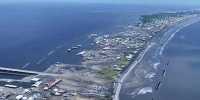While there are still unsolved concerns regarding the Nordstream gas pipeline spill from last week, satellite photographs are beginning to reveal the incident’s environmental effects. The impacted area of the water around the Danish Island of Bornholm has now been documented in before and after satellite pictures supplied by the European Space Agency (ESA).
Sentinel-1 photos from September 24 found no signs of water disruption. The same satellite detected a fierce bubble plume rising to the sea surface above the leak by the evening of September 28.
On September 27, a number of explosions and gas leaks along the Nord Stream 1 and Nord Stream 2 pipelines, which carry natural gas from Russia to Germany, were recorded. The incident made major news given the current simmering geopolitical tensions between Russia and Europe.
But many people were worried about the gas leak’s potential environmental effects in addition to its political repercussions.
The Nord Stream pipes are leaking natural gas, which is mostly composed of methane, a greenhouse gas that traps heat in the atmosphere more than 25 times more effectively than carbon dioxide. A large portion of this methane will rise to the ocean’s surface and enter the atmosphere, where it will advance the planet’s climate change.
The leak, which was the greatest single-point methane leak ever discovered by GHGSat, was estimated to be spewing out 79,000 kilograms (174,165 pounds) of natural gas per hour on September 30 by GHGSat’s satellites.
“Predictably, in order to comprehend the scope of the Nord Stream industrial calamity, the media and the rest of the world have looked to space. While we wait for more research into the source, GHGSat swiftly responded and detected 79 000 kg of methane per hour coming from the leaks. According to GHGSat Director for Europe Adina Gillespie, we will keep assigning GHGSat satellites to the Nord Stream sites until we can no longer detect emissions.
It is also worrying that the gas leak may have an immediate negative effect on the Baltic Sea ecology. A gas leak in the ocean can harm an ecosystem in a manner similar to an oil disaster. Natural gas will disintegrate into the water in substantial amounts, which might make the water poisonous for fish, shellfish, and other marine life.
Regardless of how harmful the leak may be, it’s crucial to consider the methane emissions that industry pumps into the atmosphere. The most recent release from the Nord Stream leak is reported “approximately equivalent to one and a half days of global methane emissions,” according to ESA.















